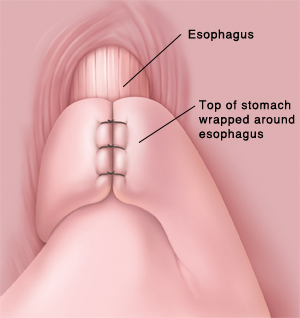Discharge Instructions for Laparoscopic Nissen Fundoplication
Laparoscopic Nissen fundoplication is done to treat gastroesophageal reflux disease (GERD). GERD occurs when food or stomach acid backs up (refluxes) from your stomach into your esophagus. This reflux can damage your esophagus. For the procedure, a few small incisions were made in your abdomen. Working through these incisions, the surgeon wrapped the upper part of your stomach around the esophagus. This creates pressure on the esophagus, helping hold it closed. The pressure helps prevent food and stomach acid from refluxing.
 |
| During a Nissen fundoplication, the topmost part of the stomach is wrapped around the lowest part of the esophagus. |
After surgery
You will likely stay in the hospital for 1 or more nights. Once you return home, follow the instructions below and any others you are given.
Activity
Here are suggestions for what you can and can't do as you recover from surgery:
-
You will likely want to take it easy for 3 days to 5 days. You can go back to your normal daily routine when you are feeling well enough. When you can return to work depends on what type of work you do. Check with your doctor.
-
Walk as often as you feel able. This will help with your recovery.
-
Don’t drive while you are still taking narcotic pain medication. Drive when you are sure you can hit the brake pedal without wincing or hesitating.
-
Continue the coughing and deep breathing exercises that you learned in the hospital.
Bandage and incision care
Your incisions will be covered by plastic bandages or strips of tape:
-
Do not get the bandage or wound wet for 48 hours.
-
You can remove plastic bandages in 48 hours. If strips of tape were used to close your incisions, don’t pull them off. Let them fall off on their own.
-
Once you can get the incision wet, very gently wash your incisions with mild soap and water. Pat them dry. Don’t use oils, powders, or lotions on your incisions.
Medication use
Take all prescribed medications as directed:
-
Until you can swallow easily, take liquid medications. If you are given pills, crush them and swallow them with liquids. However, some pills can't or shouldn't be crushed. Be sure to check with your doctor or pharmacist before crushing pills.
-
If you are given pain medication, take it on time as directed. Do not wait for pain to be severe before you take it.
-
If you are prescribed antibiotics to fight or prevent infection, be sure to take all the medication until it is gone.
-
If you have been on medications to prevent reflux, ask your doctor whether you should stop taking them.
Recommended Meal Plan Progression:
You will be given a separate diet sheet by the dietitian and instructed on the meal plan progression recommended by the dietitian and surgeon.
Keep follow-up appointments
Keep your follow-up appointments. These allow your doctor to check your progress and make sure you’re healing well. During office visits, tell your doctor if you have any new symptoms or any reflux. And be sure to ask any questions you have.
When to call your doctor
Call your doctor immediately if you have any of the following:
-
Reflux symptoms that continue or return
-
A large amount of abdominal swelling or pain, especially pain after coughing
-
Bleeding
-
Abdomen that becomes tender or feels hard
-
Increased redness or drainage of the incision
-
Fever of 100.4°F (38°C) or higher
-
Inability to drink or eat
-
Bowel movements that are black or bloody
-
Pain or tenderness in your legs
-
Chest pain or trouble breathing
|